Welcome to my monthly series about how I grow a year-round garden in a sub-tropical climate. These entries are from my personal garden journal that I keep in a simple spiral notebook. I’ll also share with you gardening tips, monthly harvests, and my favorite resources related to the season.
Here is a summary of my Garden Journal’s notes for August 2021:
Journal Entries
August was a typical hot and steamy month here in Central Florida. There was plenty of growth in the garden and a few small harvests too.
Week 1
The green bell peppers and jalapeño peppers started ripening again. This is their third blossoming since I planted them. They have been growing well in their pots with a mixture of homemade compost and commercial potting soil. Because they are in small pots, they need to be watered every day that it doesn’t rain during our hot summer season. I also fertilize them monthly. You can learn more about pepper growing from the Universty of Florida Gardening Solutions website.
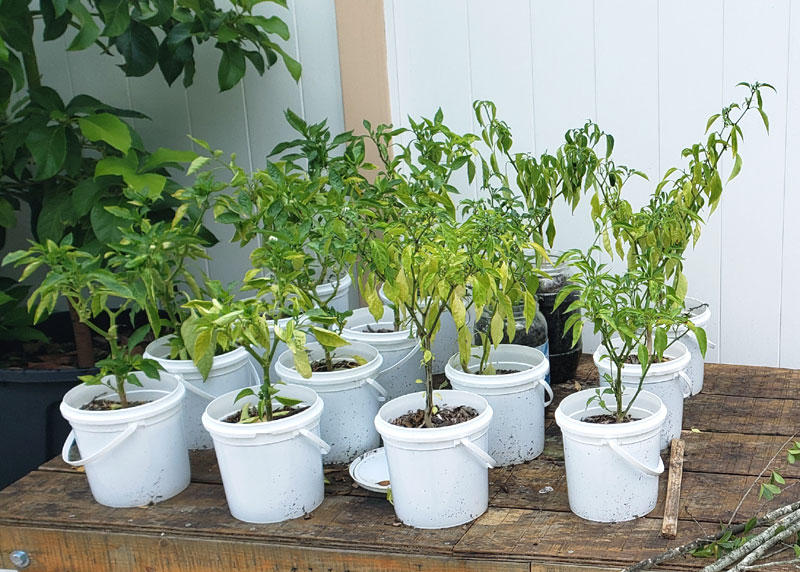
Week 2
The vining plants have enjoyed our summer heat and rainstorms. The passionfruit vines were almost out of control. I needed to trim them about every three weeks. The sweet potato vines grew fast too.
My Seminole pumpkin vines recovered from the pumpkin worm infestation last month, and started growing almost a foot a day. They took over the flower bed by the pool and the shady corner of the garden.
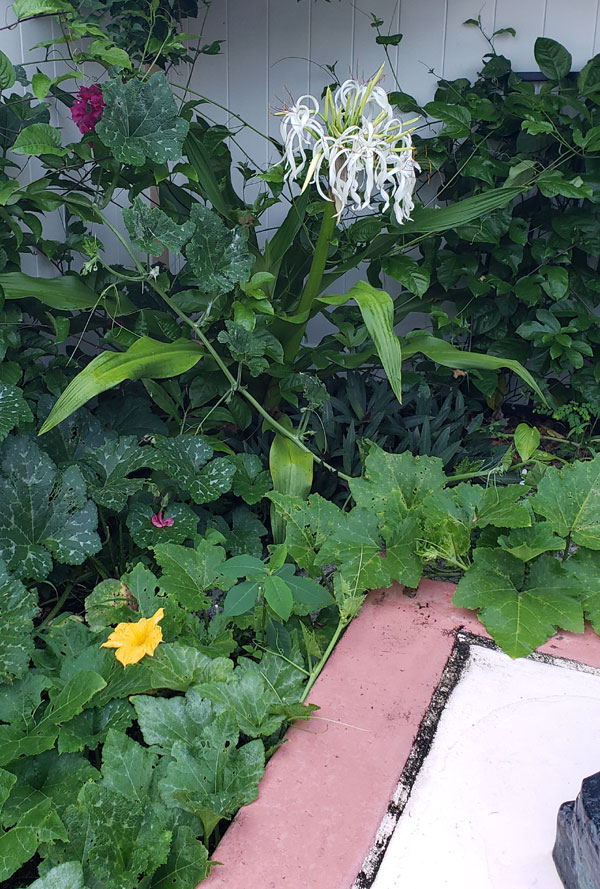
Saturday, the 14th was a busy morning. I repotted many of the plants I had received in my propagation class at our county Extension Service Agency.
I started repotting by getting the soil ready. First, I mixed 2 cubic feet of commercial raised bed gardening mix with one 5-gallon bucket of my compost from the garden.
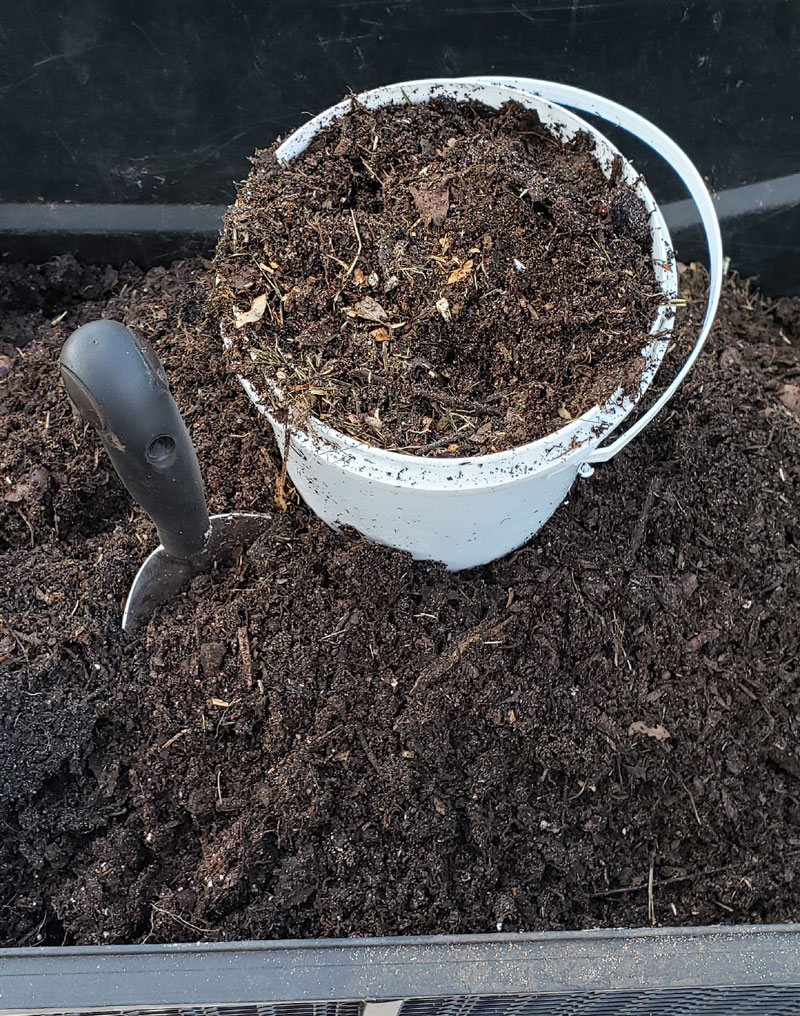
From this mix, I was able to plant my 2 fig trees in 5-gallon buckets, and 2 mulberry trees, also in 5-gallon buckets.
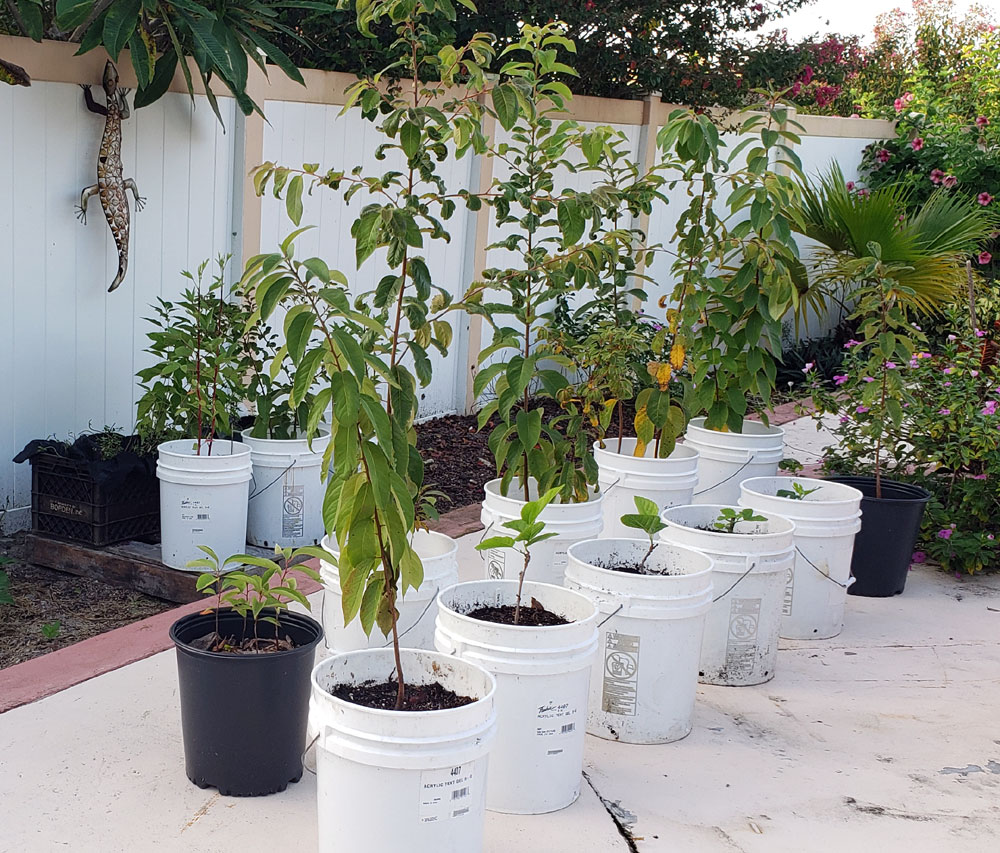
Next, I mixed up another batch of soil/compost blend.
I used this batch to repot the following:
- Planted 8 papaya tree seedlings into larger pots.
- Separated a peppermint into 2 clumps and repotted them in lined milk crates.
- Divided 2 persimmon trees from one small pot into two 5-gallon buckets.
- Separated the many Egyptian spinach plants (Molokhia)I had grown from seed into several pots.
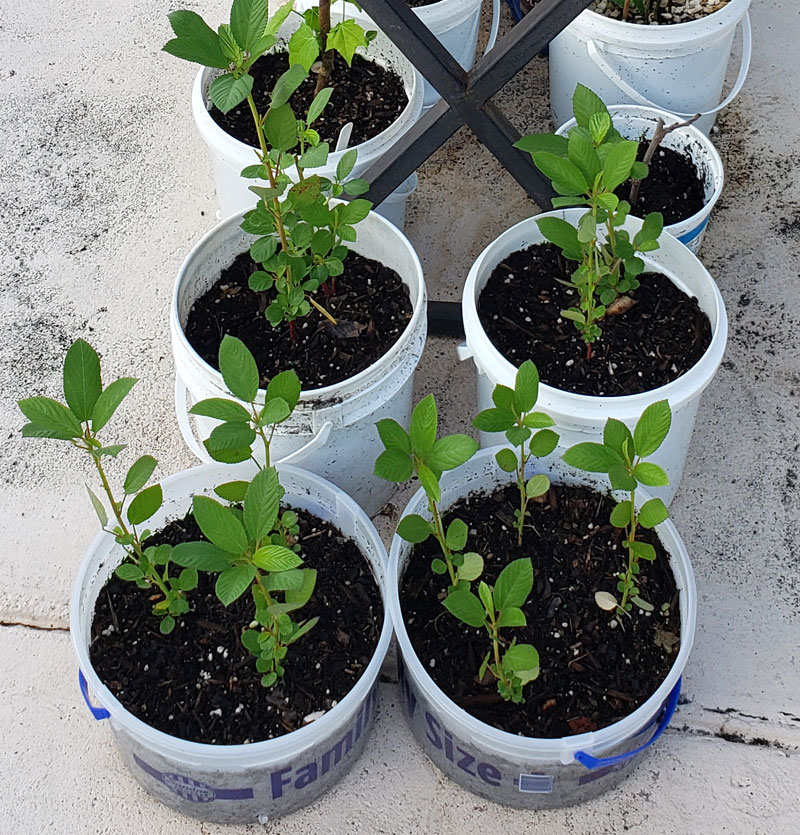
As you can see from the photos, I used several non-traditional types of garden pots.
The white 5-gallon buckets I get for free from my place of employment. After cleaning them, I drill holes in the bottom and on the sides up about one inch for drainage. They work great for starting trees and shrubs.
The pots for the papaya trees were repurposed from my propagation class.
I recently acquired for free about 2 dozen milk crates. I line them with some landscape fabric I had bought really cheap at an estate sale. It works great for drainage for potted plants.
In my garden shed I have a box full of food-grade plastic containers that I use as small pots. I drill holes in them just like the 5-gallon buckets. The lids can be used as a bottom tray to collect draining water.
Repurposing all of these containers saves me money and helps reduce my carbon footprint. You can learn about other ways I’ve been frugal in the garden from my post: Frugal 5 – Frugal in the Garden.
Week 3
Beautiful blue blossoms started appearing on my chicory plants every morning. The plants are from a lettuce mixture I had grown last winter. I’m letting them go to seed so I can grow not only greens for salads, but beautiful flowers for the garden. If you like to save seeds like I do, check out my Shop where I have several printable seed packets for sale.
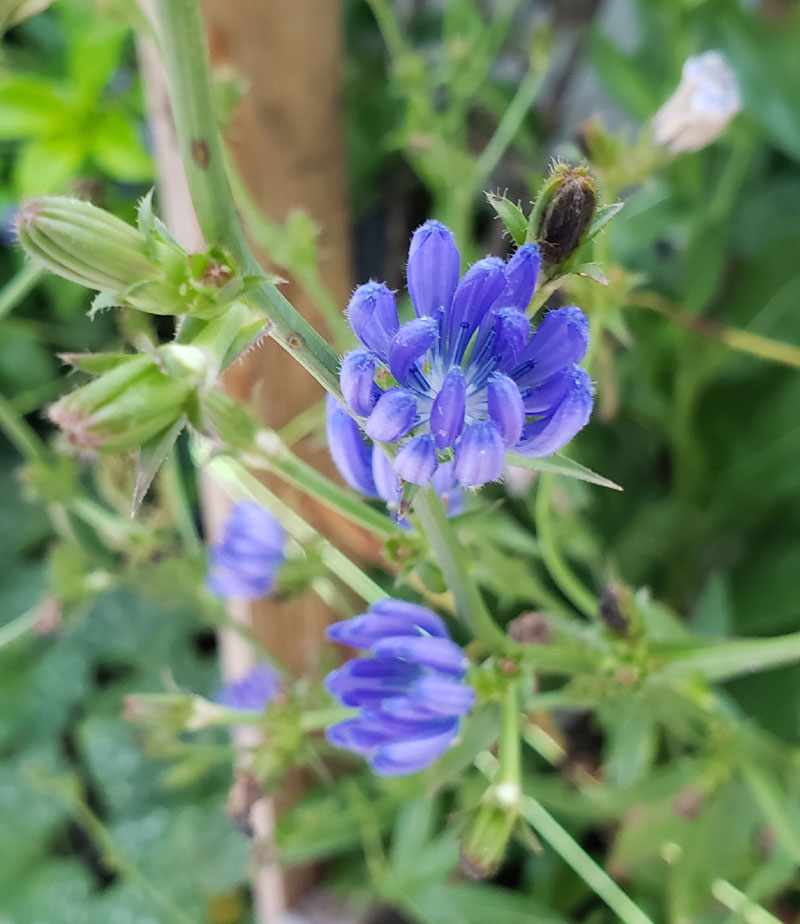
All of the plants I repotted the week before looked great and most had new growth. It inspired me to continue my propagating skills, so I cut some lemon balm and peppermint stems to try growing.
I found three small Seminole pumpkins growing under their massive leaves. These native plants are amazing! They did not get any extra fertilizer or water, yet they are growing like crazy. Plus, they are delicious!
My husband Mike and I did a taste test this week. I baked a home-grown butternut squash and one of my Seminole pumpkins one evening for dinner. I prepared them both exactly the same way, and he did not know which was which when I served them. He chose the Seminole pumpkin as the best flavor, and I agreed. Butternut squash has always been our favorite, now we have a new favorite.
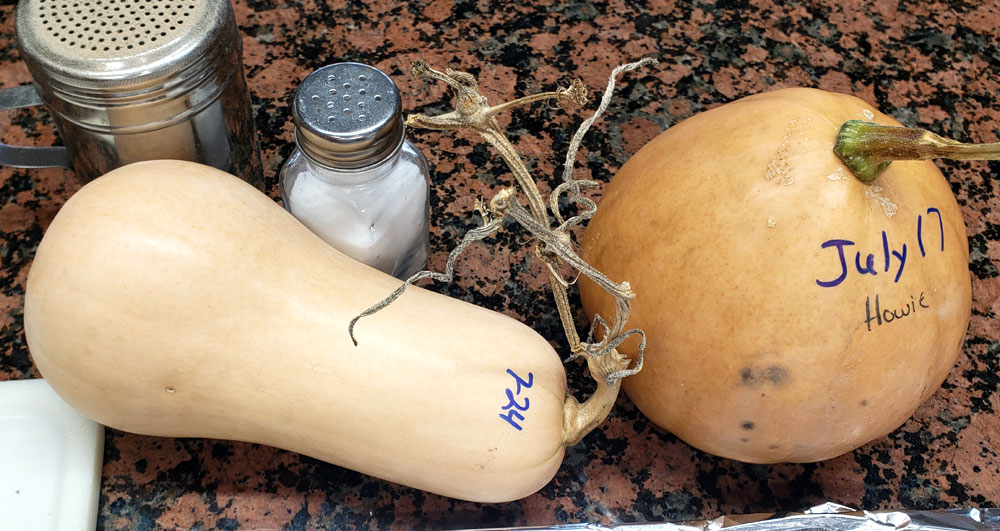
The beauty berries began ripening. I started gathering the ripe berries weekly to store them in the freezer until there would be enough to make jam. They ripen slowly, so it will be a couple of months until I have enough to make a good batch of jam.
Week 4
The passionfruit blossomed again with a total of eight this week, They continue to blossom, then fall off, with no fruit appearing. I did some research and found several reasons this may happen.
From my reading and experiences, I was able to rule out dry soil since we are in our rainy season. We have plenty of pollinators in the garden, so I didn’t think that would be the problem, but maybe I could try hand pollinating. Other causes for blossom drop might have been too much rain, wind, or high temperatures. There might also be some trace elements lacking in my soil. I will continue to trouble-shoot this problem, keeping track of everything in my journal.
Another plant that is flourishing in our hot summer weather is the roselle. Now that the daylight hours are shortening, I’ve started harvesting the calyx of the flowers. I’ll either dehydrate or freeze them for making tea.
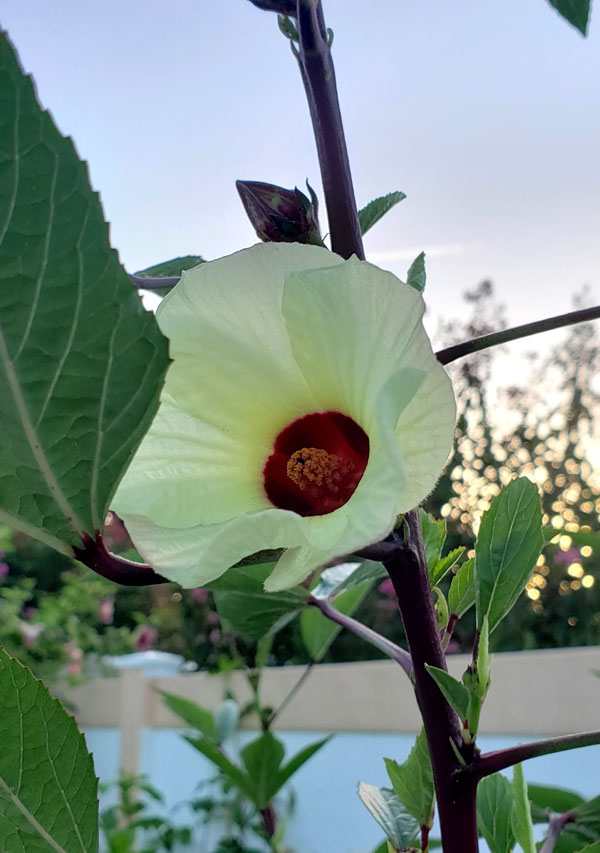
After several months of colorful blossoming, I finally pulled out all of my zinnias. They were getting a disease that left spots on the leaves and petals, and were starting to look brown and ragged. Before I pulled them out, I saved plenty of seed for the next growing season. The sweet potatoes had been growing around them, now, there is plenty of room for the potatoes to spread out.
After a quick walk through the back yard, I counted 58 fruit trees in 5-gallon buckets or pots, ready to replant at our next homestead. Here’s the count in detail:
- Lemon – 16
- Kumquat – 7
- Loquat – 3
- Avocado -4
- Jelly Fig – 2
- Black Mulberry – 3
- Persimmon – 15
- Papaya – 8
All of them have been grown from seed, or propagated from cuttings. It’s amazing how many food plants you can grow in such a small space!
Harvest Summary
Food Harvested
- Green peppers
- Jalapeno peppers
- Blackberries
- Seminole pumpkin
- Beauty berries
- Herbs: peppermint, holy basil, lemon balm, for teas
- Sweet potato leaves to put on sandwiches
- Roselle calyx for tea
Seeds Saved
- Jalapeno
- Zinnia
- Purple Coneflower
Gardening Resources
- Website: UF-IFAS Passionfruit
- Podcast: The Urban Farm Podcast
- Website: More about harvesting Florida Cranberry (roselle).
- Pepper plants are perennial!
Final Thoughts…
One of my greatest struggles as a previous northern climate gardener, was figuring out how to grow foods in the hot summers here in sub-tropical Florida. Thankfully, over the past year and a half, I’ve found many local resources for advice, online and in-person. Many of those resources I’ve shared with you monthly throughout this series.
My garden journal from 2020 has been a great reference too, for planning everything from seed starting, to pruning, to harvesting and seed saving. I strongly suggest that you use a journal or keep records in some way to make your gardening so much easier.
Now that fall is approaching, are you getting as excited as I am for the new growing season?
I’d love to know what you plant in your fall garden, especially if you garden in zone 9b. Leave me a comment below, thanks!
Until next month,
Happy Gardening!
Alisa